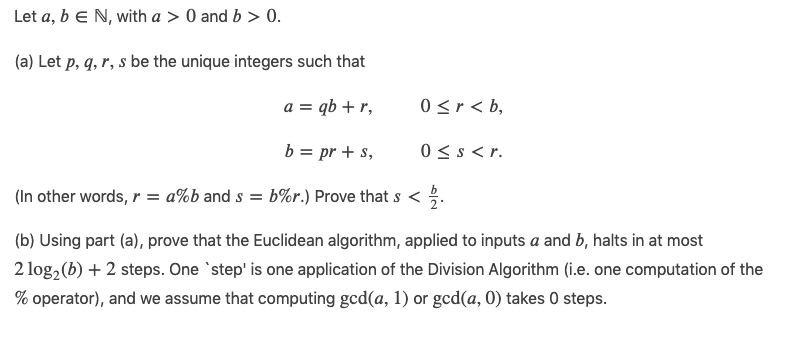Let a, b E N, with a > 0 and b > 0. (a) Let p, q, r, s be the unique integers such that a = qb +r, 0
Let a, b E N, with a > 0 and b > 0. (a) Let p, q, r, s be the unique integers such that a = qb +r, 0
Elements Of Modern Algebra
8th Edition
ISBN:9781285463230
Author:Gilbert, Linda, Jimmie
Publisher:Gilbert, Linda, Jimmie
Chapter2: The Integers
Section2.4: Prime Factors And Greatest Common Divisor
Problem 24E: Let (a,b)=1. Prove that (a,bn)=1 for all positive integers n.
Related questions
Question

Transcribed Image Text:Let a, b E N, with a > 0 and b > 0.
(a) Let p, q, r, s be the unique integers such that
a = qb + r,
0 <r < b,
b = pr + s,
0 <s < r.
(In other words, r = a%band s = b%r.) Prove that s < .
(b) Using part (a), prove that the Euclidean algorithm, applied to inputs a and b, halts in at most
2 log, (b) + 2 steps. One `step' is one application of the Division Algorithm (i.e. one computation of the
% operator), and we assume that computing gcd(a, 1) or gcd(a, 0) takes 0 steps.
Expert Solution
This question has been solved!
Explore an expertly crafted, step-by-step solution for a thorough understanding of key concepts.
Step by step
Solved in 2 steps with 2 images

Recommended textbooks for you

Elements Of Modern Algebra
Algebra
ISBN:
9781285463230
Author:
Gilbert, Linda, Jimmie
Publisher:
Cengage Learning,

Algebra & Trigonometry with Analytic Geometry
Algebra
ISBN:
9781133382119
Author:
Swokowski
Publisher:
Cengage

Elements Of Modern Algebra
Algebra
ISBN:
9781285463230
Author:
Gilbert, Linda, Jimmie
Publisher:
Cengage Learning,

Algebra & Trigonometry with Analytic Geometry
Algebra
ISBN:
9781133382119
Author:
Swokowski
Publisher:
Cengage